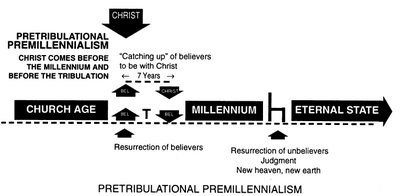Not because I wanted to get into this stuff, but because I'm committed to preaching them as they come, we've been looking at Matthew 24 these last two weeks.
By way of review. . .
The first week, we asked the question, "Could Christ come at any moment?"
Matthew 24 mentions three things that must happen before the return of Jesus:
- Birth Pangs (3-14)
- The Abomination of Desolation (15-20)
- A Great Tribulation (21-22)
The question is which, if any, of these things have happened and does it matter?
It matters . . . because of the difficulty raised by Matthew 24:34:
Truly I say to you, this generation will not pass away until all these things take place.
Jesus is emphatic here with this "Truly, I say to you. . . " He's making a point, but what is it?
I layed out three views held by Biblical Christians today:
- None of these things have taken place.
- Some of these things have taken place.
- All of these things have taken place and are continuing to take place. (yes, even "a great tribulation!")
In views 1 and 2, "generation" in 24:34 is understood to mean "race of Jews" or "last generation living when these things start to happen."
The upshot of views 1 and 2 is that the coming of Christ described in Matthew 24 could not come at any moment because these things must happen first, which kind of pulls the punch on Jesus' instructions to be alert and ready in v. 36 and following.
Those who subscribe to view #1, believe that a rapture of the church, which is not mentioned in Matthew 24, makes Jesus instructions to alertness and readiness still relevant. But it seems crazy that since the disciples are asking about the unfolding of the end times in v. 3 that Jesus wouldn't tell them about the rapture. Isn't this a bit misleading?
But according to view #3, all these things really did take place in the generation of the disciples around the destruction of Jerusalem in AD 66-70 AND they are continuing to take place throughout the church age. Jesus, then, is describing the general characteristics of the church age between His comings. The upshot of view #3 is is that 24:34 is straightforwardly fulfilled and Jesus might return at any moment. We are living in the last days.
Do you see the rub? Do you sense the tension? Do you see the implications? Which view do you hold?
I've held all three views at one time or another in my Chrsitian walk and study of the Scriptures. Shockingly. . . at present, I lean toward and loosely hold to view #3 for the following reasons:
- It’s the most natural reading of the text in its original historical and cultural context. Jesus means what He says. We take Jesus' words as his disciples would have heard them. We don’t have to reengineer or explain away the word “generation” to fit our interpretation.
- View #3 supports the NT teaching that Christ could indeed come again at any moment. This seems to fit with the text that immediately follows where the exhortation is “be on the alert for you do not know which day your Lord is coming.” We really should be alert. (I believe that views #1 and #2 undermine our need for alertness.)
- View #3 explains the Apostolic expectation that preserves the reliability of Scripture. The Apostles, writing under the inspiration of the Holy Spirit, expressed their belief that it was "the end of all things was near" (I Peter 4:7). . . that it was the last hour (1 John 2:18). . . and that the coming of the Lord was near (James 5:7 & 8). It was. . . then and now because all that needed to happen before Jesus comes again has happened. They were near then. We are nearer now.
So, this is a brief summary of August 6. If you missed it, you can listen online.
I've received a bunch of emails and I'll share some of the questions and responses in future posts, but first I'll summaraze August 13 in the next post.
In the meantime, you can tee off in the comments section. . . . let's be charitable and humble with one another since these are non-essentials.














